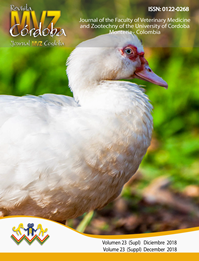Rickettsia typhi in rodents from a community with history of murine typhus from Yucatan, Mexico.
Rickettsia typhi en roedores de una comunidad con antecedentes de tifo murino, de Yucatán, México.
Show authors biography
Objective. To determine the presence of Rickettsia typhi in synanthropic rodents captured in the rural community of Bolmay, Yucatan, Mexico, an area with history of murine typhus cases. Materials and methods. Thirty Mus musculus, 6 Rattus rattus and 1 Heteromys gaumeri were examined. Total DNA was obtained of rodent’s spleen. The identification of Rickettsia typhi was performed through the fragment’s amplification of the htrA (17-kDa gene protein) by endpoint PCR. The positive products were purified and sent for sequencing and analysis with the BLAST tool. Results. Rickettsial DNA was identified in 27% (10/37) of the rodents: seven M. musculus and 3 R. rattus. The alignment analyses obtained identity and coverage percentages of 97 - 99% for R. typhi. Conclusions. The present study suggests the participation of synanthropic rodents in the murine typhus cycle in the region. We described the first molecular evidence of R. typhi in M. musculus of Yucatan, Mexico.
Article visits 1635 | PDF visits
Downloads
- Mansueto P, Vitale G, Cascio A, Seidita A, Pepe I, Carroccio A, et al. New insight into immunity and immunopathology of Rickettsial diseases. Clin Dev Immunol. 2012; 2012:967852.
- Shpynov SN, Fournier PE, Pozdnichenko, Gumenuk AS, Skiba AA. New approaches in the systematics of rickettsiae. New Microbes New Infect. 2018; 23:93-102. https://doi.org/10.1016/j.nmni.2018.02.012
- Dzul-Rosado K, González-Martínez P, Peniche-Lara G, Zavala-Velázquez J, Zavala-Castro J. Murine typhus in humans, Yucatan, Mexico. Emerg Infect Dis. 2013; 19(6):1021-1022. https://doi.org/10.3201/eid1906.121400
- Eisen RJ, Gage KL. Transmission of flea-borne zoonotic agents. Annu Rev Entomol. 2012; 57:61-82. https://doi.org/10.1146/annurev-ento-120710-100717
- Martínez-Ortiz D, Torres-Castro M, Koyoc-Carde-a E, López K, Panti-May A, Rodríguez-Vivas I, et al. Detección molecular de Rickettsia typhi en perros de una comunidad rural de Yucatán, México. Biomedica. 2016; 36(Supl. 1):45-50.
- Panti-May JA, Hernández-Betancourt S, Ruíz-Pi-a H, Medina-Peralta S. Abundance and population parameters of commensal rodents present in rural households in Yucatan, Mexico. Int Biodeterior Biodegradation. 2012;66:77-81. https://doi.org/10.1016/j.ibiod.2011.10.006
- Webb L, Carl M, Malloy D, Dasch G, Azad A. Detection of Murine Typhus in fleas by using the Polymerase Chain Reaction. J Clin Microb. 1990; 28(3):530-534.
- Sosa-Gutiérrez C, Vargas M, Torres J, Gordillo-Pérez G. Tick-Borne Rickettsial pathogens in rodents from Mexico. J Biomedical Science and Engineering. 2014; 7(11):884-889. https://doi.org/10.4236/jbise.2014.711087
- Panti-May JA, Hernández-Betancourt SF, Torres-Castro MA, Machain-Williams C, Cigarroa-Toledo N, Sodá L, et al. Population characteristics of human-commensal rodents present in households from Mérida, Yucatán, México. MANTER Journal of Parasite Biodiversity. 2016. Occasional paper 5:1-6.
- Peniche-Lara G, Dzul-Rosado K, Pérez-Osorio C, Zavala-Castro J. Rickettsia typhi in rodents and R. felis in fleas in Yucatan as a possible causal agent of undefined febrile cases. Rev Inst Med Trop Sao Paulo. 2015; 57(2):129-132. https://doi.org/10.1590/S0036-46652015000200005
- Panti-May JA, Torres-Castro M, Hernández-Betancourt S, Dzul-Rosado K, Zavala-Castro J, López K, et al. Detection of Rickettsia felis in wild mammals from three municipalities in Yucatan, Mexico. Ecohealth. 2015; 12(3):523-527. https://doi.org/10.1007/s10393-014-1003-2
- Lledó L, Gegúndez I, Ruiz E, Rodríguez L, Bacellar F, Saz JV. Rickettsia typhi infection in wild rodents from central Spain. Ann Trop Med Parasitol. 2003; 97(4):411-414. https://doi.org/10.1179/000349803235002344
- Chareonviriyaphap T, Leepitakrat W, Lerdthusnee K, Chao CC, Ching WM. Dual exposure of Rickettsia typhi and Orientia tsutsugamushi in the field-collected Rattus rodents from Thailand. J Vector Ecol. 2014; 39(1):182-189. https://doi.org/10.1111/j.1948-7134.2014.12085.x
- Kuo CC, Shu PY, Mu JJ, Wang HC. High prevalence of Rickettsia spp. infections in small mammals in Taiwan. Vector Borne Zoonotic Dis. 2015;15(1):13-20. https://doi.org/10.1089/vbz.2014.1584
- Quintero JC, Londo-o AF, Díaz FJ, Agudelo-Flórez P, Arboleda M, Rodas JD. Ecoepidemiología de la infección por rickettsias en roedores, ectoparásitos y humanos en el noreste de Antioquia, Colombia. Biomedica. 2013; 33(Supl. 1):38-51.
























